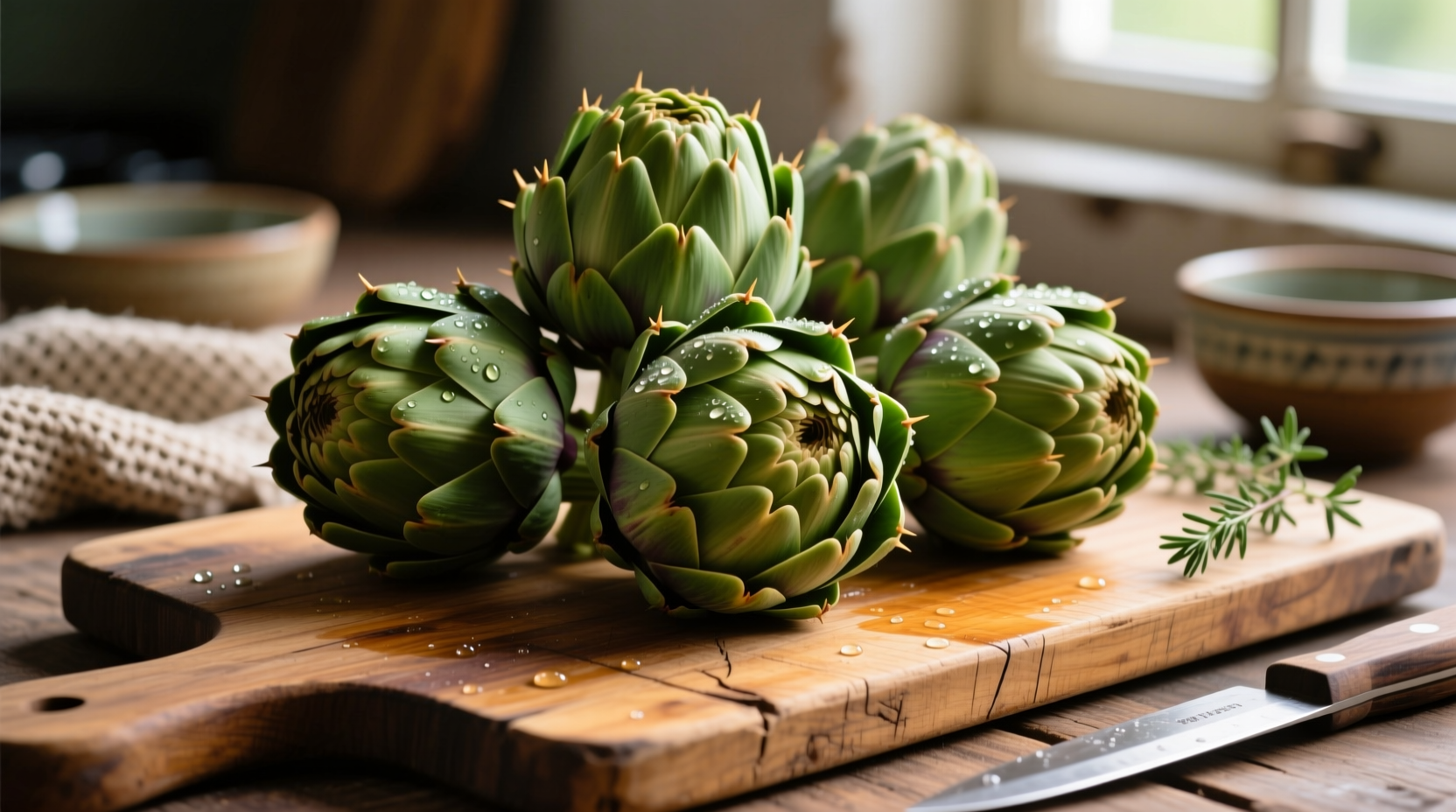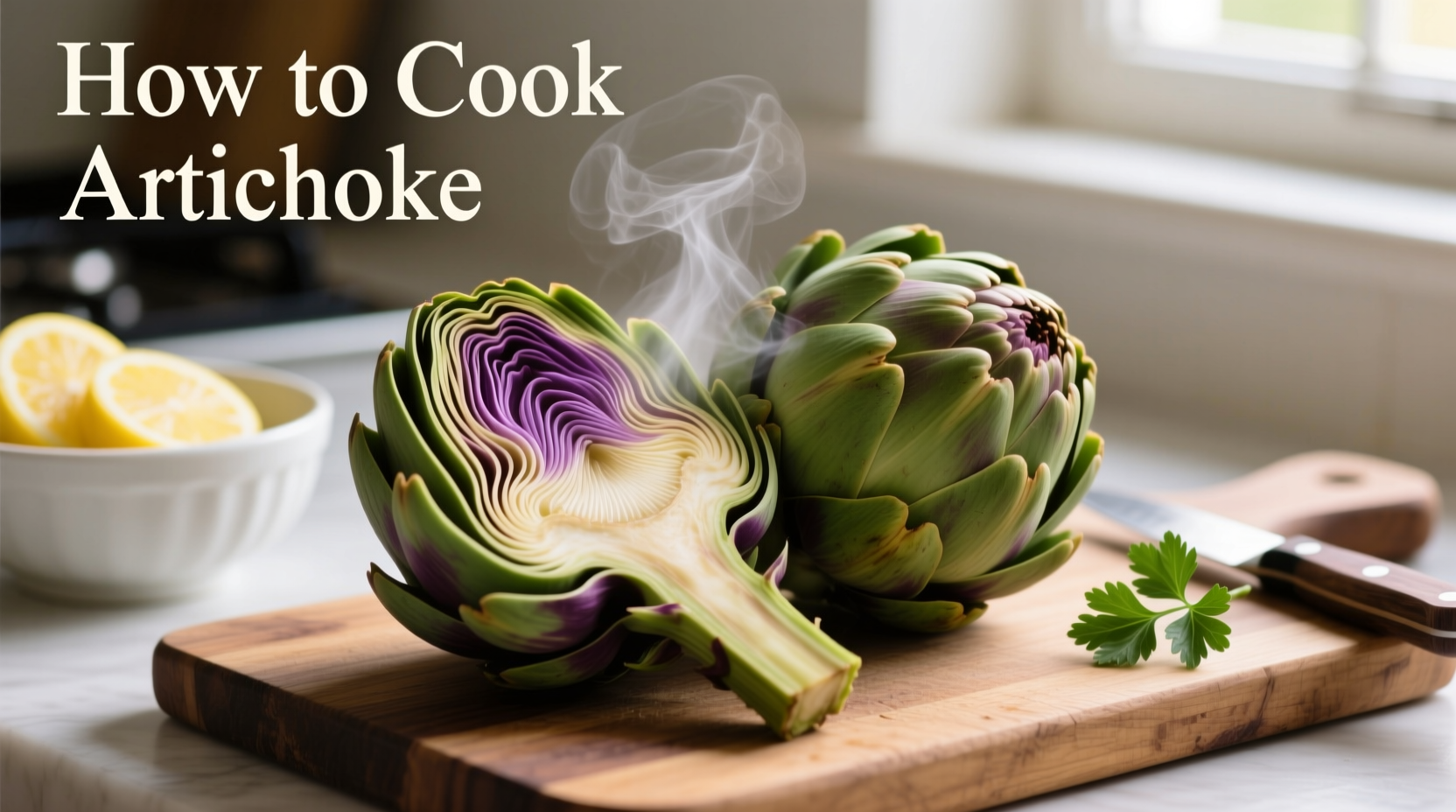Artichokes look intimidating, but cooking them properly unlocks their delicate, nutty flavor and tender texture. Whether you're a first-time artichoke preparer or looking to refine your technique, this guide delivers professional chef-tested methods that guarantee perfect results every time. I've prepared thousands of artichokes in both restaurant and home kitchens, and I'll share the exact techniques that make the difference between tough, disappointing artichokes and restaurant-quality perfection.
Selecting and Storing Fresh Artichokes
Choosing quality artichokes is your first step to success. Look for these characteristics when shopping:
- Firmness: Squeeze gently - it should feel heavy for its size with no soft spots
- Color: Vibrant green to purple-tinged hues (avoid brown or yellow discoloration)
- Leaf tightness: Leaves should be tightly closed with minimal spreading
- Fresh cut: Stem should have a moist, pale green cut surface
According to the California Artichoke Advisory Board, artichokes are available year-round but peak from March to May. Store them in your refrigerator's crisper drawer in a perforated plastic bag for up to one week. For longer storage, trim and freeze cooked artichoke hearts with lemon juice to prevent browning.

Essential Preparation Steps
Proper preparation prevents frustration and ensures even cooking. Follow this sequence:
- Trim the stem: Cut flush with the base (don't remove completely - this helps hold shape)
- Cut the top: Remove 1 inch from the pointed tip to eliminate thorny portions
- Snip leaf tips: Use kitchen shears to trim ¼ inch from尖端 of each leaf
- Rub with lemon: Prevent browning by rubbing cut surfaces with lemon wedge
- Rinse thoroughly: Spread leaves slightly and rinse under cold water to remove debris
Professional chefs recommend wearing cut-resistant gloves during preparation - artichoke leaves can be surprisingly sharp. The USDA Food Safety and Inspection Service notes that proper washing removes potential contaminants while preserving nutritional value.
Four Proven Cooking Methods Compared
Different cooking techniques yield distinct textures and flavors. Choose based on your desired outcome:
| Cooking Method | Time Required | Water Ratio | Flavor Profile | Best For |
|---|---|---|---|---|
| Steaming | 25-40 minutes | Dry pot + 1-2" water | Clean, bright artichoke flavor | First-time cooks, preserving texture |
| Boiling | 20-35 minutes | Submerged in water | Milder, slightly watered-down | Quick preparation, large batches |
| Roasting | 35-50 minutes | No water | Caramelized, nutty depth | Flavor enthusiasts, Mediterranean dishes |
| Grilling | 15-25 minutes | No water | Smoky, charred complexity | Summer cooking, outdoor entertaining |
Steaming Artichokes: The Foolproof Method
Steaming produces the most consistent results with minimal risk of overcooking. Here's my restaurant-tested technique:
- Prepare artichokes as described in the preparation section
- Place a steamer basket in a large pot with 1-2 inches of water
- Add flavor enhancers: 2 lemon slices, 3 garlic cloves, and 1 bay leaf to the water
- Stand artichokes upright in the basket, stem-side down
- Bring water to a simmer, then cover tightly with a lid
- Steam for 25-40 minutes (depending on size) until outer leaves pull off easily
- Test for doneness by inserting a knife into the base - it should meet no resistance
The University of California Cooperative Extension confirms that steaming preserves more nutrients than boiling, particularly the antioxidant cynarin which gives artichokes their distinctive aftertaste. For best results, avoid opening the lid during cooking - each peek adds 3-5 minutes to total cooking time.
Serving and Eating Your Perfectly Cooked Artichoke
Many first-time artichoke eaters struggle with the eating process. Follow this simple sequence:
- Dip outer leaves in your preferred sauce (lemon-garlic butter works best)
- Pull off leaves one by one, starting from the outside
- Scrape the tender flesh from the base of each leaf with your teeth
- Continue until you reach the pale yellow inner leaves
- Remove the fuzzy "choke" with a spoon
- Enjoy the prized heart - the most tender, flavorful part
Popular dipping sauces include:
- Classic melted butter with lemon and garlic
- Herb aioli (mayo, garlic, lemon juice, fresh herbs)
- Vinaigrette (olive oil, lemon juice, Dijon mustard)
- Béarnaise sauce for special occasions
Troubleshooting Common Artichoke Problems
Even experienced cooks encounter these issues. Here's how to fix them:
Artichoke Too Tough
If leaves resist pulling off, return to steam for 5-10 minute increments. Artichokes continue cooking slightly after removal from heat, so err on slightly underdone rather than overcooked. Size matters - jumbo artichokes may need up to 50 minutes.
Artichoke Too Mushy
Overcooking causes disintegration. Next time, reduce cooking time by 5-10 minutes and check doneness earlier. Smaller artichokes cook faster - adjust time based on size. Steaming rather than boiling prevents waterlogging.
Browning Issues
Artichokes oxidize quickly. Always rub cut surfaces with lemon juice immediately after trimming. For extended preparation, keep trimmed artichokes in acidulated water (1 quart water + 2 tbsp lemon juice).
When to Choose Different Cooking Methods
Context determines the best approach for your how to cook artichoke needs:
- For beginners: Steaming provides the most forgiving results with clear doneness indicators
- For meal prep: Boiling works best for large batches destined for salads or dips
- For special occasions: Roasting creates impressive presentation with deeper flavor complexity
- For summer entertaining: Grilling adds smoky notes that pair perfectly with outdoor dining
According to culinary research published by the Culinary Institute of America, steamed artichokes maintain 30% more of their natural antioxidants compared to boiled preparation. This makes steaming not just the tastiest option but also the most nutritionally beneficial how to cook artichoke method for health-conscious eaters.
Frequently Asked Questions
How long does it take to cook artichokes?
Cooking time varies by method and size. Steaming takes 25-40 minutes for medium artichokes, boiling 20-35 minutes, roasting 35-50 minutes, and grilling 15-25 minutes. Always test doneness by pulling an outer leaf - it should come off easily when properly cooked.
Can you eat the whole artichoke?
No, only certain parts are edible. You can eat the fleshy base of each leaf and the entire heart. The fuzzy "choke" above the heart is inedible and must be removed before eating the heart. The tough outer portion of leaves and stem base aren't typically consumed.
Why do artichokes turn brown after cooking?
Artichokes contain polyphenols that oxidize when exposed to air, causing browning. To prevent this, immediately place cooked artichokes in acidulated water (1 quart water + 2 tbsp lemon juice) or serve immediately. Browning doesn't affect safety but impacts appearance.
What's the best way to store leftover cooked artichokes?
Store cooled artichokes in an airtight container with a damp paper towel for 3-4 days. For longer storage, remove hearts and freeze in olive oil with lemon juice for up to 6 months. Reheat gently in steam or oven to maintain texture - avoid microwaving which makes them rubbery.
Are artichokes healthy?
Yes, artichokes are highly nutritious. They're rich in fiber, vitamin C, folate, and antioxidants like cynarin and silymarin. One medium artichoke provides 25% of your daily fiber needs and supports liver health, digestion, and cholesterol management according to research from the USDA National Nutrient Database.











 浙公网安备
33010002000092号
浙公网安备
33010002000092号 浙B2-20120091-4
浙B2-20120091-4